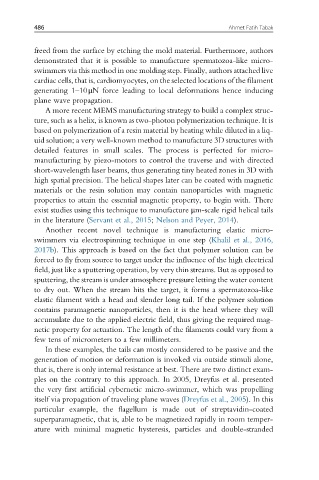Page 492 - Handbook of Biomechatronics
P. 492
486 Ahmet Fatih Tabak
freed from the surface by etching the mold material. Furthermore, authors
demonstrated that it is possible to manufacture spermatozoa-like micro-
swimmers via this method in one molding step. Finally, authors attached live
cardiac cells, that is, cardiomyocytes, on the selected locations of the filament
generating 1–10μN force leading to local deformations hence inducing
plane wave propagation.
A more recent MEMS manufacturing strategy to build a complex struc-
ture, such as a helix, is known as two-photon polymerization technique. It is
based on polymerization of a resin material by heating while diluted in a liq-
uid solution; a very well-known method to manufacture 3D structures with
detailed features in small scales. The process is perfected for micro-
manufacturing by piezo-motors to control the traverse and with directed
short-wavelength laser beams, thus generating tiny heated zones in 3D with
high spatial precision. The helical shapes later can be coated with magnetic
materials or the resin solution may contain nanoparticles with magnetic
properties to attain the essential magnetic property, to begin with. There
exist studies using this technique to manufacture μm-scale rigid helical tails
in the literature (Servant et al., 2015; Nelson and Peyer, 2014).
Another recent novel technique is manufacturing elastic micro-
swimmers via electrospinning technique in one step (Khalil et al., 2016,
2017b). This approach is based on the fact that polymer solution can be
forced to fly from source to target under the influence of the high electrical
field, just like a sputtering operation, by very thin streams. But as opposed to
sputtering, the stream is under atmosphere pressure letting the water content
to dry out. When the stream hits the target, it forms a spermatozoa-like
elastic filament with a head and slender long tail. If the polymer solution
contains paramagnetic nanoparticles, then it is the head where they will
accumulate due to the applied electric field, thus giving the required mag-
netic property for actuation. The length of the filaments could vary from a
few tens of micrometers to a few millimeters.
In these examples, the tails can mostly considered to be passive and the
generation of motion or deformation is invoked via outside stimuli alone,
that is, there is only internal resistance at best. There are two distinct exam-
ples on the contrary to this approach. In 2005, Dreyfus et al. presented
the very first artificial cybernetic micro-swimmer, which was propelling
itself via propagation of traveling plane waves (Dreyfus et al., 2005). In this
particular example, the flagellum is made out of streptavidin-coated
superparamagnetic, that is, able to be magnetized rapidly in room temper-
ature with minimal magnetic hysteresis, particles and double-stranded

